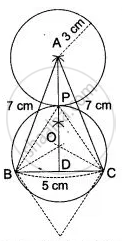Advertisements
Advertisements
प्रश्न
(a) Only the ruler and compass may be used in this question. All contraction lines and arcs must be clearly shown and be of sufficient length and clarity to permit assessment.
(i) Construct a ABC, such that AB = AC = 7 cm and BC = 5 cm.
(ii) Construct AD, the perpendicular bisector of BC.
(iii) Draw a circle with center A and radius 3 cm. Let this circle cut AD at P.
(iv) Construct another circle, to touch the circle with center A, externally at P, and pass through B and C.
उत्तर

Steps of construction:
(i) 1) Draw BC = 5 cm.
2) With B and C as centres draw two arcs to length 7 cm cutting each at A.
3) Join AB and AC
4) Then ABC is required triangle.
(ii) Draw AD, the right bisector of BC.
(iii) With A as centre and radius 3 cm draw a circle meeting AD in P.
(iv) 1) Join BP and CP.
2) Draw the right bisector of CP meeting AD in O.
3) With O as centre and radius equal to Op draw the required circle, passing through B and C.
APPEARS IN
संबंधित प्रश्न
Construct the rhombus ABCD whose diagonals AC and BD are of lengths 8 cm and 6 cm respectively. Construct the inscribed circle of the rhombus. Measure its radius.
Using ruler and compass construct a cyclic quadrilateral ABCD in which AC = 4 cm, ∠ ABC = 60°, AB 1.5 cm and AD = 2 cm. Also, write the steps of construction.
